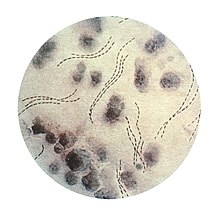
Back باستوريلات Arabic باستوريلات ARZ Pasteurel·làcies Catalan Pasteurellaceae German Pasteurellaceae Spanish Pasteurellaceae French Pasteureláceas GL Pasteurellaceae Dutch Pasteurellaceae Portuguese 巴斯德氏菌科 Chinese
| Pasteurellaceae | |
|---|---|

| |
| Haemophilus ducreyi | |
| Scientific classification | |
| Domain: | Bacteria |
| Phylum: | Pseudomonadota |
| Class: | Gammaproteobacteria |
| Order: | Pasteurellales Garrity et al. 2005 |
| Family: | Pasteurellaceae Castellani & Chalmers, 1919 |
| Genera | |
|
Actinobacillus | |
The Pasteurellaceae comprise a large family of Gram-negative bacteria. Most members live as commensals on mucosal surfaces of birds and mammals, especially in the upper respiratory tract.[3] Pasteurellaceae are typically rod-shaped, and are a notable group of facultative anaerobes. Their biochemical characteristics can be distinguished from the related Enterobacteriaceae by the presence of oxidase, and from most other similar bacteria by the absence of flagella.
Bacteria in the family Pasteurellaceae have been classified into a number of genera based on metabolic properties, but these classifications are not generally accurate reflections of the evolutionary relationships between different species. Haemophilus influenzae was the first organism to have its genome sequenced and has been studied intensively by genetic and molecular methodologies. The genus Haemophilus is a notorious human pathogen associated with bacteremia, pneumonia, meningitis and chancroid. Other pathogenic members of the family Pasteurellaceae include Aggregatibacter, Mannheimia, Pasteurella, and Actinobacillus species.
- ^ Parker, Charles Thomas; Garrity, George M. (2018). Parker, Charles Thomas; Garrity, George M (eds.). "Taxonomy of the genus Caviibacterium Adhikary et al. 2018". doi:10.1601/tx.31260.
{{cite journal}}: Cite journal requires|journal=(help) - ^ Parker, Charles Thomas; Garrity, George M. (2018). Parker, Charles Thomas; Garrity, George M (eds.). "Taxonomy of the genus Conservatibacter Adhikary et al. 2018". doi:10.1601/tx.31262.
{{cite journal}}: Cite journal requires|journal=(help) - ^ Kokotovic, Branko; Friis, Niels F; Ahrens, Peter (2007). "Mycoplasma alkalescens demonstrated in bronchoalveolar lavage of cattle in Denmark". Acta Veterinaria Scandinavica. 49 (1): 2. doi:10.1186/1751-0147-49-2. ISSN 1751-0147. PMC 1766361. PMID 17204146.